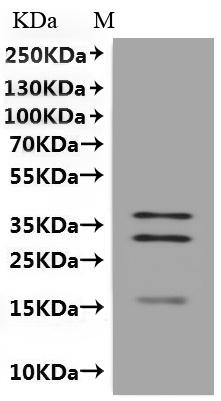This Recombinant Human STEAP1 protein comes from a mammalian cell system, which appears to help with proper post-translational modifications and protein folding. The sequence runs from amino acids 1 to 339 - essentially the full-length protein - and includes a C-terminal 10xHis-tag that makes purification and detection more straightforward. What's interesting here is the use of a Virus-Like Particle (VLP) platform. The protein contains six transmembrane domains, which likely makes its structure closer to what we'd see in native forms. Worth noting that purity details aren't available for VLP proteins.
STEAP1 belongs to the six-transmembrane epithelial antigen of prostate family and seems to play a role in metal ion transport. The protein may be involved in cellular ion homeostasis and has drawn attention in cancer biology research, especially regarding prostate cancer. Its function in metal reduction and transport suggests it could be important for understanding how cells proliferate and differentiate.
Potential Applications
Note: The applications listed below are based on what we know about this protein's biological functions, published research, and experience from experts in the field. However, we haven't fully tested all of these applications ourselves yet. We'd recommend running some preliminary tests first to make sure they work for your specific research goals.
Based on the provided information, the recombinant Human STEAP1 is expressed as virus-like particles (VLPs) in a mammalian cell system. This expression system is highly advantageous for producing complex membrane proteins like STEAP1, which contains 6 transmembrane domains. Mammalian cells provide the appropriate cellular machinery for proper folding, post-translational modifications, and membrane integration. The VLP format further supports native-like membrane presentation. While protein activity is unverified, the expression system makes it highly probable that the protein is correctly folded. However, without specific functional validation (e.g., metalloreductase activity for STEAP1), bioactivity cannot be guaranteed.
1. Membrane Protein Immunogenicity Studies
This application is well-supported. The VLP platform presents STEAP1 in its native transmembrane conformation, making it suitable for studying immune responses against membrane protein epitopes. The full-length expression ensures all potential epitopes are present. This is a valid use case even without activity verification, as it relies primarily on structural presentation.
2. VLP-Based Antibody Development and Screening
This application is appropriate. The VLP presentation helps preserve conformational epitopes, which is advantageous for generating antibodies recognizing the native protein structure. However, the note about the His-tag enabling purification and attachment should be qualified - while the tag facilitates initial purification, its utility for attachment in native conditions may be limited if it's only functional under denaturing conditions (a common limitation for membrane protein tags).
3. Membrane Protein-VLP Interaction Studies
This application requires significant qualifications. While the VLP format provides a membrane environment for studying STEAP1, tags are often inaccessible in native conditions. Interaction studies would require careful optimization and validation with alternative methods.
4. Vaccine Antigen Presentation Research
This application is theoretically possible but requires caution. While VLPs are excellent antigen presentation platforms, STEAP1 is a self-protein (human antigen), and its use in vaccine research carries potential risks of autoimmune responses. It should emphasize basic research applications rather than direct vaccine development. The comparison between soluble and VLP-presented forms is valid for mechanistic studies.
Final Recommendation & Action Plan
This STEAP1-VLP preparation appears most suitable for immunogenicity studies and antibody development applications where native conformation is important. For functional studies, initial validation of protein activity should be performed using appropriate assays (e.g., metalloreductase activity tests). For interaction studies, alternative approaches not relying on tag accessibility should be considered. Given the self-antigen nature of STEAP1, any vaccine-related applications should focus on basic research with appropriate ethical considerations. The mammalian expression system and VLP format provide confidence in protein folding quality, making this reagent valuable for structural and immunological applications.






